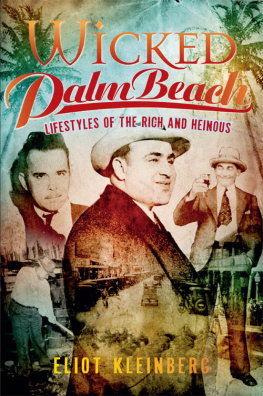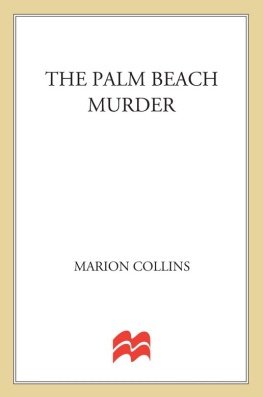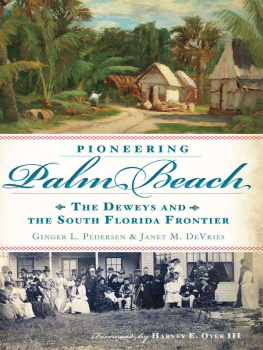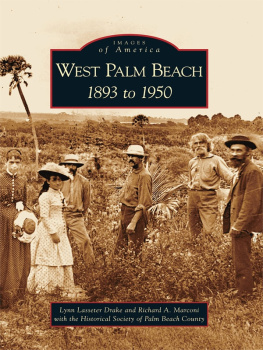
ADDISON MIZNER

An imprint of Globe Pequot
Distributed by NATIONAL BOOK NETWORK
Copyright 2018 by Stephen Perkins and James Caughman
All rights reserved. No part of this book may be reproduced in any form or by any electronic or mechanical means, including information storage and retrieval systems, without written permission from the publisher, except by a reviewer who may quote passages in a review.
British Library Cataloguing in Publication Information Available
Library of Congress Cataloging-in-Publication Data
Names: Perkins, Stephen, 1950- author. | Caughman, James, 1947- author.
Title: Addison Mizner : the architect whose genius defined Palm Beach / Stephen Perkins and James Caughman.
Description: Guilford, Connecticut: Lyons Press, 2018. | Includes bibliographical references and index.
Identifiers: LCCN 2017047411 (print) | LCCN 2017047833 (ebook) | ISBN 9781493026562 (e-book) | ISBN 9781493026555 (hardback : alk. paper)
Subjects: LCSH: Mizner, Addison, 1872-1933. | ArchitectsUnited StatesBiography.
Classification: LCC NA737.M59 (ebook) | LCC NA737.M59 P47 2018 (print) | DDC 720.92 [B]dc23
LC record available at https://lccn.loc.gov/2017047411
 The paper used in this publication meets the minimum requirements of American National Standard for Information SciencesPermanence of Paper for Printed Library Materials, ANSI/NISO Z39.48-1992.
The paper used in this publication meets the minimum requirements of American National Standard for Information SciencesPermanence of Paper for Printed Library Materials, ANSI/NISO Z39.48-1992.
Printed in the United States of America

CHAPTER ONE
I JOSH AND I PAINT
O n a gray day, late in the afternoon of February 9, 1933, hundreds of people were making their way to Worth Avenue in Palm Beach to honor the life of a dear friend who had passed away only four days earlier. The rain that washed over the resort city would generally be interpreted as an appropriate symbol for a day of mourning; however, this memorial service that attracted so many people could only be a celebration. Unacquainted with sentimentality, Addison Mizner had specified in his will that there be no funeral service, that his ashes be buried without fanfare in California. Aware of Addison Mizners wishes, his friends still insisted on a secular service to honor their special companion, always an indefatigable source of warmth and wit and forever the inimitable author of architectural beauty.

Addison Mizner was known as a society architect who adapted the Mediterranean Revival style to the climate and topography of South Florida. By designing houses to accommodate the social requirements of his clientele, he transformed the Palm Beach lifestyle from one of regulated activity centered around Henry Flaglers hotels to a more relaxed, informal manner of living focused on personal entertaining. His architecture still defines Palm Beach.
Courtesy of Historical Society of Palm Beach County.
Many visitors that day were already familiar with their destination; those who had never been inside the Villa Mizner would happily find a home that reflected with absolute fidelity the nature and interests of the man they had come to commemorate. The living room, although very large, was insufficient to accommodate the throng of guests, necessitating many to gather in the vaulted foyer and on the tiled steps leading to the main floor. The remarkable feature of this congregation was its diversity, from friends and clients of high social station to laborers and artisans of the working class. Addison Mizner knew well the difference between the two but possessed the gift of sincerely liking both. His attraction to a person was governed less by social position and more by individual character and skill, a point of view that created disparate associations throughout his colorful life. In this setting, people who would ordinarily not share the same space were united in admiration and appreciation for a remarkable friend.
Addisons living room was a window into his capacious mind. Spanish furniture and carvings from the sixteenth and seventeenth centuries, large tapestries, and a collection of crucifixes that had been displayed at the Boston Museum of Fine Arts blended with terra cotta floor tiles, wrought iron chandeliers, and a dramatic beamed ceiling to reflect his powerful affinity for the noble charm of Old Spain and its colonies. These personal objects were outlined on the rainy afternoon by a soft, pale light diffused through the stained glass of three Moorish windows. The dim glow that washed over the room created an effect redolent of the Old World, of a distant time that was so familiar to Addison Mizner. The guests were witnessing the material biography of the homes owner.
The living room and foyer were also filled with the fragrance of hundreds of flowers, gifts from tradesmen as well as the social elite. One leader of Palm Beach sending flowers was his friend and client Mrs. Edward Eva Stotesbury. So congested was Villa Mizner that Queen Eva, as Addison playfully called her as a result of her social prominence, had to stand with her husband in the foyer outside the crowded living room. She recognized early Addisons towering talent and was the first to offer him a residential commission in Palm Beach in 1919. Excusing herself to push into the great room, she wanted to verify that her orange blossoms were resting on Addisons favorite chair.
Although the service was devotional and not religious, Addisons good friend, the Reverend Nathaniel Seymour Thomas, opened with a prayer. He then read passages of poetry from the Romantics who, like Addison himself, created expressive works through richness of imagery and description. Each selection of verse spoke to a prominent attribute of the architect. In reading from Percy Bysshe Shelleys Adonas , the poignant lament composed for the dead John Keats, Thomas suggested the timelessness of Addisons architectural legacy:

Living Room, Villa Mizner, 1924. The gathering place for Addisons memorial service, the large living room featured the Spanish furniture, tapestries, and antiquities that so captivated the architect. The stained glass, wrought iron chandeliers, terra cotta floor tiles, and architectural stonework were all made in the workshops of Mizner Industries, a collection of artisanal manufactories begun by Mizner.
Photograph by Frank E. Geisler reproduced by Craig Kuhner.
Forget the Past, his fate and fame shall be
An echo and a light unto eternity!
He also read from Shelleys Prometheus Unbound , likening the creative architect to the mythical figure who gave humanity fire, the symbol representing the imaginative powers of thought. Finally, he read from Alfred Lord Tennysons Crossing the Bar in which the poet reminds friends to have a placid attitude toward death and not to lament his passing. This was a reminder to all present that Addison Mizner reveled in life, even in its darkest moments, and wished his friends to celebrate him, not to mourn his passing.
Next page










 The paper used in this publication meets the minimum requirements of American National Standard for Information SciencesPermanence of Paper for Printed Library Materials, ANSI/NISO Z39.48-1992.
The paper used in this publication meets the minimum requirements of American National Standard for Information SciencesPermanence of Paper for Printed Library Materials, ANSI/NISO Z39.48-1992.

